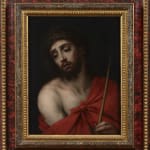Bartolomé Esteban Murillo (1617-1682)
Further images
Exhibitions
Splendor of Andalusian Baroque, CajaSur Foundation, Caja Sur Museum Exhibition Hall, Córdoba, from 30 October to 2 December, 2007. Hospital de la Caridad, Seville, from 15 December, 2007 to 20 January, 2008.
Baroque Spirit, Caja de Burgos. La Casa del Cordón, Burgos, from 22 February 22 to 4 May, 2008.
Demeanors, Caja Segovia Social Work, Torreón de Lozoya, Segovia, from 1 July to 7 November, 2011.
Literature
Palencia, José M., Esplendor de barroco andaluz (Splendor of Andalusian Baroque) exh. cat., 2007, p. 74; Palencia, José M., Espíritu barroco (Baroque Spirit) exh. cat., 2008; Martínez Leiva, G. y Rodríguez Rebollo, A., Semblantes (Demeanors) exh. cat., 2011.
The Ecce Homo by Murillo that belonged to the Granados collection shows Christ, who appears represented from the torso, just from under the chest. The light, which bathes the effigy from above, is concentrated on the upper part of the face and shoulder of the figure of Jesus, concentrating the viewer's attention on these points. His body appears slightly rotated presenting itself in three quarters, while the head is turned to one side, diverting the gaze to the side, thus creating a rupture in the frontal nature of the theme. In the same way, compositional verticality is also subtly broken by the face slightly inclined and by the mantle, of an intense red tone, that breaks diagonally the composition, while from the knot that sustains it, the shades of its folds are described in all directions, creating an effect of compositional complexity, within the apparent simplicity. The cane that is held by an almost imperceptible hand gives the painting a touch of color that separates it from a total two-color. This balance is commonplace in Murillo's work, both in simple compositions and in the most ambitious ones.
Read Catalogue
This website uses cookies
This site uses cookies to help make it more useful to you. Please contact us to find out more about our Cookie Policy.








